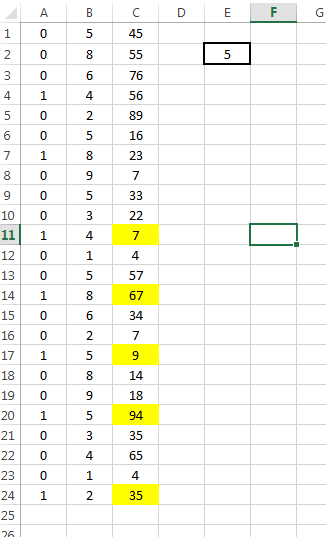I have a spreadsheet with a large bit of statistics on it. NFL Stats for quarterbacks with every game of their career. First game is on the top and each line below it is his next game's stats.
On another sheet I have formulas already that shows his totals for whatever amount of games I put in cell A1. For instance if I type "30" into A1 then the line of stats next to that will show the totals for the first 30 games of his career.
The image below is created for a simplified answer of course, but I was wondering how I can do this same thing but it would give the totals for the "last" 30 games of his career instead of the first 30. Reversing the order of the stats is not an option.
So for the image below, how would I write a formula that will add up the totals of only the last (however many as the number in cell E2) cells in column C that have a 1 in the same row in column A? (I colored the cells yellow to help clarify which cells I am talking about.)
with a 5 in E2 the formula would return 212
if E2 has 3 in it, the formula would return 138

Thanks ahead of time for any help.
On another sheet I have formulas already that shows his totals for whatever amount of games I put in cell A1. For instance if I type "30" into A1 then the line of stats next to that will show the totals for the first 30 games of his career.
The image below is created for a simplified answer of course, but I was wondering how I can do this same thing but it would give the totals for the "last" 30 games of his career instead of the first 30. Reversing the order of the stats is not an option.
So for the image below, how would I write a formula that will add up the totals of only the last (however many as the number in cell E2) cells in column C that have a 1 in the same row in column A? (I colored the cells yellow to help clarify which cells I am talking about.)
with a 5 in E2 the formula would return 212
if E2 has 3 in it, the formula would return 138

Thanks ahead of time for any help.

![[glasses] [glasses] [glasses]](/data/assets/smilies/glasses.gif) Just traded in my OLD subtlety...
Just traded in my OLD subtlety...![[tongue] [tongue] [tongue]](/data/assets/smilies/tongue.gif)